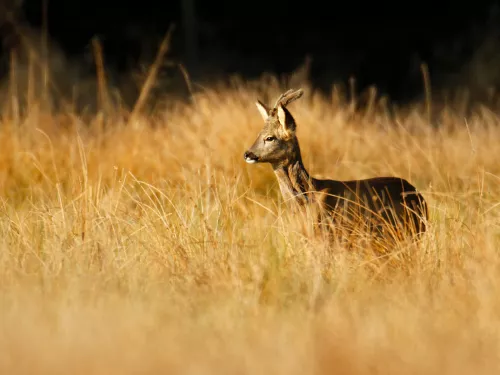Rock goby
This little fish is found in rockpools during the summer months and has a clever adaptation that stops it being swept away by strong waves - their pelvic fins are fused to form a sucker that it uses to cling onto rocks.
This little fish is found in rockpools during the summer months and has a clever adaptation that stops it being swept away by strong waves - their pelvic fins are fused to form a sucker that it uses to cling onto rocks.
A common and stocky bird of our rocky coasts, the rock pipit can nearly always be seen close to the sea. It is a bit smaller than a starling.

The attractive roe deer is native to the UK and widespread across woodland, farmland, grassland and heathland habitats. Look for its distinctive pale rump and short antlers.
The song of the Roesel's bush-cricket is very characteristic: long, monotonous and mechanical. It can be heard in rough grassland, scrub and damp meadows in the south of the UK, but it is spreading north.
The all-black rook is a sociable bird, so can be spotted in flocks or nesting colonies, known as 'rookeries'. Unlike the similar carrion crow, it has a grey bill and 'baggy trouser' feathers around its legs.
The rose chafer can be spotted on garden flowers, as well as in grassland, woodland edges and scrub.
A tall plant, Rosebay willowherb is a successful coloniser; it can form dense stands of bright pink flower spikes on disturbed ground, such as woodland clearings, verges and waste ground.
This beautiful beetle only arrived in the UK in 1960s but is now a common sight on garden herbs.
A 'weed' of cultivated and disturbed ground, Round-leaved fluellen is a trailing plant with round leaves and yellow flowers that appear over summer.
The carnivorous lifestyle of the round-leaved sundew makes this heathland plant a fascinating species. The round leaves have sticky, 'dew'-covered tendrils that tempt in unsuspecting insects as prey.
Often a lone figure on a windswept mountainside or heath, the Rowan tree can stand for up to 200 years. It is well known for its masses of red berries that attract all kinds of birds, including thrushes.
As its name suggests, the ruby elfcup is a bright red, cup-shaped fungus. It is widespread, but scarce, and can be found on fallen twigs and branches, particularly in areas with higher rainfall.